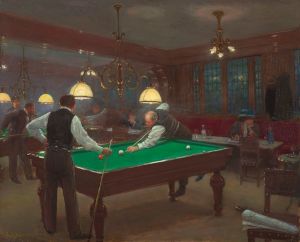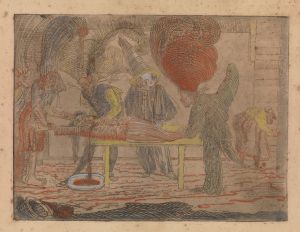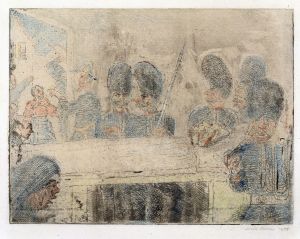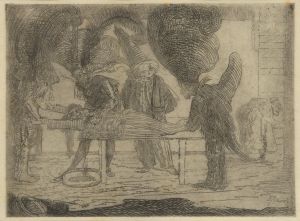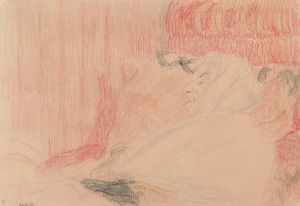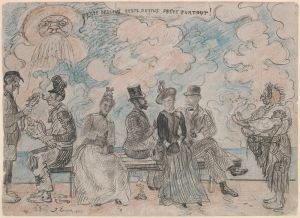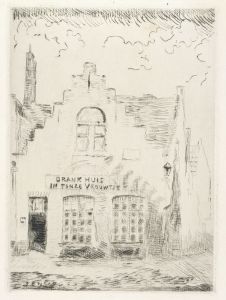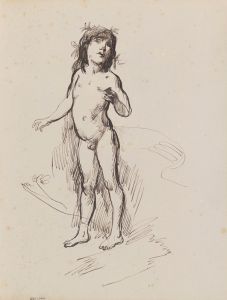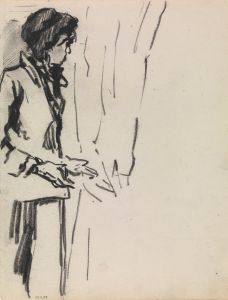
Biljartspelende geraamten
A hand-painted replica of James Ensor’s masterpiece Biljartspelende geraamten, meticulously crafted by professional artists to capture the true essence of the original. Each piece is created with museum-quality canvas and rare mineral pigments, carefully painted by experienced artists with delicate brushstrokes and rich, layered colors to perfectly recreate the texture of the original artwork. Unlike machine-printed reproductions, this hand-painted version brings the painting to life, infused with the artist’s emotions and skill in every stroke. Whether for personal collection or home decoration, it instantly elevates the artistic atmosphere of any space.
"Biljartspelende geraamten" (Billiard-Playing Skeletons) is a painting by the Belgian artist James Ensor, created in 1896. Ensor, known for his eccentric and imaginative style, was a prominent figure in the Symbolist movement and is often associated with the avant-garde art scene of the late 19th and early 20th centuries. His work frequently explored themes of death, absurdity, and the grotesque, often using skeletons and masks as recurring motifs.
The painting "Biljartspelende geraamten" is a quintessential example of Ensor's fascination with the macabre and the surreal. It depicts a group of skeletons engaged in a game of billiards, a scene that juxtaposes the mundane activity of playing a game with the eerie presence of death. This contrast is a hallmark of Ensor's work, reflecting his interest in the absurdity of life and the inevitability of death.
Ensor's use of skeletons can be interpreted as a commentary on the human condition, highlighting the transient nature of life and the futility of worldly pursuits. The skeletons in the painting are animated and lively, suggesting that even in death, there is a continuation of human activities and follies. This theme resonates with the broader Symbolist movement, which often sought to express the unseen and the metaphysical through symbolic imagery.
The painting is characterized by Ensor's distinctive use of color and light. He employs a vibrant palette, with bold contrasts that enhance the surreal quality of the scene. The skeletal figures are rendered with a playful yet unsettling energy, their bony forms stark against the richly colored background. This use of color and form is typical of Ensor's style, which often blends elements of realism with fantastical and dreamlike imagery.
James Ensor was born in Ostend, Belgium, in 1860, and he spent much of his life in this coastal city. His upbringing in a family of curio shop owners exposed him to a wide array of objects and artifacts, which influenced his artistic development. Ensor's work was initially met with resistance and criticism, as his unconventional style and subject matter challenged the artistic norms of his time. However, he eventually gained recognition and acclaim, becoming a significant influence on later artists, including the Surrealists.
"Biljartspelende geraamten" reflects Ensor's unique vision and his ability to blend humor with existential themes. The painting invites viewers to contemplate the paradoxes of life and death, using the familiar setting of a billiard game to explore deeper philosophical questions. Ensor's work remains influential and continues to be celebrated for its originality and its contribution to the development of modern art.
Today, James Ensor is regarded as one of Belgium's most important artists, and his works are held in high esteem in museums and collections worldwide. "Biljartspelende geraamten" is a testament to his innovative spirit and his enduring legacy in the art world.






